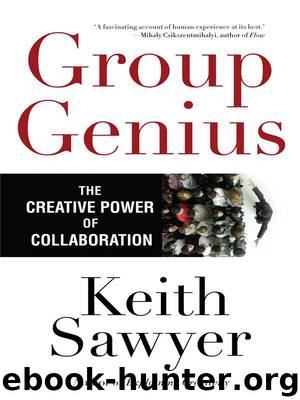Group Genius: The Creative Power of Collaboration by Keith Sawyer

Author:Keith Sawyer [Sawyer, Keith]
Language: eng
Format: mobi
Publisher: Basic Books
Published: 2008-03-03T14:00:00+00:00
Conversational Insight
Stories such as these inspired me to begin my studies of creativity by listening to ordinary people’s conversations. I videotaped these conversations, transcribed them, and then applied interaction analysis, the same technique I used to study improv theater. This work—and that of colleagues around the world—provided a clear view of how creativity emerges from collaborative conversation. Ronald Carter, a professor of linguistics at the University of Nottingham in England and the leader of the CANCODE corpus, one of the largest conversational taping projects in the world, found thousands of examples of creativity in his five-million-word database. For example, Carter captured the freewheeling conversation of three art school students. Mary was wearing dangly earrings that were falling apart, and the various pieces were swinging around.
MARY: It’s my earring.
BETH: Oh. Lovely. Oh. Lovely.
MARY: It’s fallen apart a bit.
BETH: It looks quite nice like that actually. I like that. I bet, is that supposed to be straight?
MARY: Yeah.
BETH: I reckon it looks better like that.
MARY: And it was another bit as well, was another dangly bit. Separate. BETH: What attached to that one?
MARY: The top bit. Yeah. So it was even.
STACY: Mobile earrings.
BETH: Oh.
MARY: [Laughs]
BETH: I like it like that. It looks better like that.
MARY: Oh, what did I see. What did I see. Stained glass. There was . . . I went to a craft fair, um, Bristol. And they had this stained glass stall and it was all mobiles made out of stained glass.
STACY: Oh, wow.
Stacy joked that they were “mobile earrings,” a conceptual combination of earrings and the mobile—a type of art sculpture that hangs from the ceiling and moves in the breeze. At the same time, she was making a pun on the noun “mobile” and the adjective “mobile,” meaning something that moves around. It’s like PANCAKE BOAT, but it emerged from the group.
These women aren’t just being creative to score conversational points and impress their friends—they use these moments to reinforce their common bonds. Building on the “mobile earrings” creation, Mary next told a story about visiting a craft fair and seeing an artist who’d created mobiles made from stained glass. She took the new concept of “mobile earrings” and built on it to take the conversation in a different, creative direction—again, one that reinforced their shared experience.
Since 1990, I’ve been studying what goes on in collaborative teams, and I’ve found that conversation is wonderfully improvisational as long as we open ourselves up and let it happen. Here’s an example of an improvisational conversation between a manager, Theresa, and an interface designer, Tony, at a software company. Tony has just realized that to make the interface more user-friendly, the software will have to be changed. But he’s not sure which changes to make and he doesn’t have the authority to order them to be made. As they improvise together, an unexpectedly creative solution emerges.
TONY: Theresa, when you get a minute could you come here?
THERESA: Sure. Just a sec.
THERESA: What’s the problem?
TONY: The problem is that some of the files need to go on the Web server, and some on the video server.
Download
This site does not store any files on its server. We only index and link to content provided by other sites. Please contact the content providers to delete copyright contents if any and email us, we'll remove relevant links or contents immediately.
Nudge - Improving Decisions about Health, Wealth, and Happiness by Thaler Sunstein(7242)
Deep Work by Cal Newport(6563)
Principles: Life and Work by Ray Dalio(5961)
The Doodle Revolution by Sunni Brown(4502)
Factfulness: Ten Reasons We're Wrong About the World – and Why Things Are Better Than You Think by Hans Rosling(4487)
Eat That Frog! by Brian Tracy(4149)
Thinking in Bets by Annie Duke(3996)
Hyperfocus by Chris Bailey(3902)
Visual Intelligence by Amy E. Herman(3620)
Writing Your Dissertation in Fifteen Minutes a Day by Joan Bolker(3573)
How to Win Friends and Influence People in the Digital Age by Dale Carnegie & Associates(3366)
Ogilvy on Advertising by David Ogilvy(3329)
Hidden Persuasion: 33 psychological influence techniques in advertising by Marc Andrews & Matthijs van Leeuwen & Rick van Baaren(3292)
How to win friends and influence people by Dale Carnegie(3269)
The Pixar Touch by David A. Price(3209)
Schaum's Quick Guide to Writing Great Short Stories by Margaret Lucke(3187)
Deep Work: Rules for Focused Success in a Distracted World by Cal Newport(2980)
Work Clean by Dan Charnas(2892)
The Slow Fix: Solve Problems, Work Smarter, and Live Better In a World Addicted to Speed by Carl Honore(2837)
